The fire resistant cable market is projected to grow from USD 2.1 billion in 2025 to USD 2.7 billion by 2030, generating an incremental gain of USD 0.6 billion over the first five years, which represents 37.5% of the total incremental growth over the 10-year forecast period. This early-phase growth is driven by the increasing demand for fire-resistant cables in critical infrastructure such as power generation, transportation, and industrial sectors, where safety standards and regulations are becoming more stringent. The rise in construction activities, particularly in high-rise buildings and large-scale industrial plants, further fuels this demand.
The second half (2030–2035) will contribute USD 1.0 billion, representing 62.5% of the total growth, reflecting stronger momentum as fire safety regulations continue to evolve and as industries like automotive and oil & gas adopt more robust safety measures. Annual increments will rise from USD 0.1 billion in early years to USD 0.2 billion by 2035, reflecting an accelerated pace of growth driven by technological advancements in cable production and stricter compliance with global safety norms. Manufacturers focusing on high-quality, cost-effective fire-resistant cables will capture the largest share of this USD 1.6 billion opportunity.
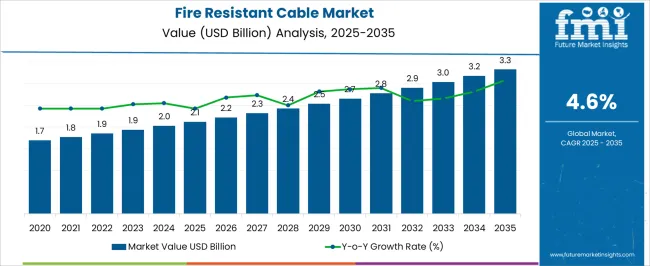
| Metric | Value |
|---|---|
| Fire Resistant Cable Market Estimated Value in (2025 E) | USD 2.1 billion |
| Fire Resistant Cable Market Forecast Value in (2035 F) | USD 3.3 billion |
| Forecast CAGR (2025 to 2035) | 4.6% |
The fire resistant cable market is expanding steadily due to growing awareness of fire safety regulations, increasing investments in critical infrastructure, and the global push for low-toxicity, halogen-free materials in construction and industrial sectors. As regulatory bodies enforce stricter fire performance criteria for cables used in energy, transportation, and building systems, demand has risen for cables that can maintain circuit integrity and limit toxic smoke emission during combustion.
These cables are being increasingly installed in airports, tunnels, high-rise buildings, hospitals, and oil and gas facilities, where failure of power or communication systems during a fire event can lead to severe consequences. Innovation in fire retardant sheathing compounds and evolving European and international standards such as EN 50200 and IEC 60331 are also influencing the replacement of conventional materials with advanced fire rated solutions.
Future growth is expected to be fueled by urban expansion, green building initiatives, and a stronger emphasis on life safety systems embedded in smart infrastructure projects globally.
The fire resistant cable market is segmented by insulation material, and geographic regions. By insulation material, the fire resistant cable market is divided into Low Smoke Zero Halogen (LSZH), Polyvinyl Chloride (PVC), Ethylene Propylene Rubber-Insulated (EPR), Cross Linked Poly Ethylene (XLPE), and Others. Regionally, the fire resistant cable industry is classified into North America, Latin America, Western Europe, Eastern Europe, Balkan & Baltic Countries, Russia & Belarus, Central Asia, East Asia, South Asia & Pacific, and the Middle East & Africa.
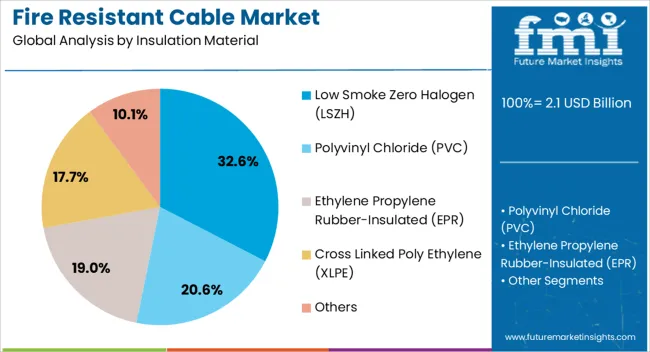
The low smoke zero halogen LSZH insulation material subsegment is projected to account for 32.6% of the fire resistant cable market revenue share in 2025. The leading position of this subsegment is attributed to its ability to significantly reduce the emission of toxic and corrosive gases during fire incidents while maintaining flame resistance and mechanical performance.
LSZH materials are being widely adopted across commercial and industrial installations due to increasing emphasis on human health and asset protection in enclosed spaces such as railways, data centers, airports, and public infrastructure. The segment’s growth is further supported by rising compliance requirements in line with environmental and fire safety directives across regions such as the European Union and Asia Pacific.
The insulation's compatibility with high voltage and low voltage applications, along with advancements in polymer compounding technologies, has enabled its use in both new installations and retrofit projects. Its non-toxic emission profile and ability to limit visibility impairment during smoke formation have made LSZH the preferred material for mission-critical environments prioritizing occupant safety.
The fire-resistant cable market is driven by increasing demand for safety standards, with significant opportunities arising from infrastructure projects in emerging markets. Trends in green and flexible fire-resistant cables are reshaping the industry, while challenges like high production costs and regulatory compliance remain. By 2025, addressing these challenges and capitalizing on opportunities in growing infrastructure and safety demands will be essential for maintaining growth and innovation in the fire-resistant cable market.
The fire-resistant cable market is growing due to the increasing need for safety and fire prevention in industries like construction, manufacturing, and energy. Regulatory bodies are tightening safety standards, mandating the use of fire-resistant cables in buildings, power plants, and industrial facilities to prevent fire hazards. The growing focus on fire safety, coupled with the rising construction of high-rise buildings and infrastructure, will continue to drive demand for fire-resistant cables through 2025, ensuring safer environments in various sectors.
The fire-resistant cable market is witnessing significant opportunities in emerging markets where infrastructure development is expanding rapidly. Countries in Asia Pacific, Latin America, and the Middle East are witnessing a construction boom, resulting in increased demand for fire-resistant cables. Moreover, investments in energy projects such as power plants, renewables, and transmission lines are further fueling market growth. By 2025, these developing regions will become key growth areas for fire-resistant cables, presenting ample opportunities for market players to expand their reach and deliver solutions that meet rising safety demands.
Emerging trends in the fire-resistant cable market include the increasing focus on environmentally friendly and flexible cables. Manufacturers are developing fire-resistant cables with materials that offer lower environmental impact while maintaining high-performance characteristics. The demand for flexible cables that are easier to install and more versatile for various applications is also on the rise. By 2025, these trends will continue to evolve, as industries seek sustainable and adaptable solutions that meet fire safety regulations while supporting environmental goals and reducing installation time.
The fire-resistant cable market faces challenges such as high production costs and stringent regulatory compliance. The manufacturing of fire-resistant cables requires advanced materials and specialized processes, leading to higher production costs compared to standard cables. Furthermore, maintaining compliance with evolving safety regulations and certifications across different regions adds to the complexity of operations. By 2025, overcoming these barriers will be crucial for manufacturers to stay competitive while offering cost-effective and compliant fire-resistant cable solutions to the growing market.
| Country | CAGR |
|---|---|
| China | 6.2% |
| India | 5.8% |
| Germany | 5.3% |
| France | 4.8% |
| UK | 4.4% |
| USA | 3.9% |
| Brazil | 3.5% |
The global fire-resistant cable market is projected to grow at a 4.6% CAGR from 2025 to 2035. China leads with a growth rate of 6.2%, followed by India at 5.8%, and Germany at 5.3%. The United Kingdom records a growth rate of 4.4%, while the United States shows the slowest growth at 3.9%. These varying growth rates are driven by increasing demand for safety solutions, particularly in sectors such as construction, energy, and industrial applications, where fire resistance is critical. Emerging markets like China and India are experiencing higher growth due to rapid industrialization, infrastructure development, and increased safety awareness, while more mature markets like the USA and the UK see steady growth driven by advancements in fire safety standards, building regulations, and growing demand for reliable and safe electrical systems. This report includes insights on 40+ countries; the top markets are shown here for reference.
The fire-resistant cable market in China is growing rapidly, with a projected CAGR of 6.2%. China’s expanding industrial base, coupled with increasing construction activities and government regulations promoting fire safety, is driving significant demand for fire-resistant cables. The country’s growing focus on building safety standards and urbanization continues to boost the adoption of fire-resistant cables in residential, commercial, and industrial applications. Additionally, China’s commitment to improving energy infrastructure and expanding the use of electrical systems in various industries accelerates the demand for reliable and safe electrical wiring solutions. The growing focus on renewable energy sources, including solar and wind power, also increases the demand for fire-resistant cables in energy systems.
The fire-resistant cable market in India is projected to grow at a CAGR of 5.8%. India’s rapidly expanding infrastructure and industrial sectors, combined with increasing government focus on fire safety regulations, are driving the demand for fire-resistant cables. The country’s rising focus on enhancing electrical systems in residential, commercial, and industrial buildings, along with the growing construction sector, further accelerates the demand for fire-resistant cables. Additionally, India’s increasing energy requirements, coupled with rising investments in renewable energy, continue to boost the adoption of fire-resistant cables in energy systems and power distribution. As urbanization progresses and building safety becomes more prioritized, the demand for fire-resistant solutions continues to rise.
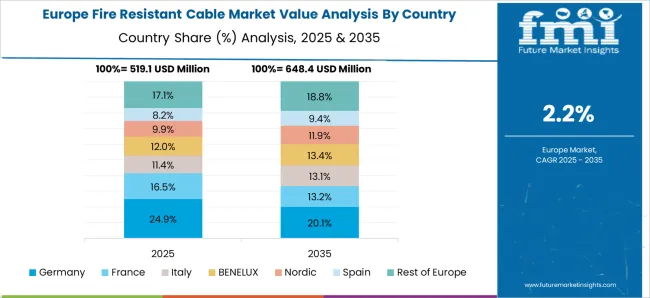
The fire-resistant cable market in Germany is projected to grow at a CAGR of 5.3%. Germany’s strong focus on building safety, combined with stringent regulatory frameworks supporting fire safety standards, continues to drive steady market growth. The country’s growing infrastructure development, particularly in industrial, commercial, and residential buildings, increases the demand for fire-resistant cables. Additionally, Germany’s leadership in energy-efficient solutions and renewable energy systems further accelerates the need for fire-resistant cables in these applications. As part of the European Union’s broader commitment to sustainability and safety, Germany’s adoption of modern fire safety codes and standards continues to support the market’s growth.
The fire-resistant cable market in the United Kingdom is projected to grow at a CAGR of 4.4%. The UK’s increasing focus on fire safety standards, combined with rising demand for reliable electrical systems in residential, commercial, and industrial buildings, continues to drive steady market growth. The country’s stringent regulations on fire safety, along with growing construction activities and infrastructure development, further fuel the demand for fire-resistant cables. Additionally, the UK’s push toward greener buildings and smart cities increases the need for safe and efficient electrical systems, boosting market expansion. The increasing adoption of fire-resistant cables in renewable energy systems and power distribution networks also contributes to the market’s growth.
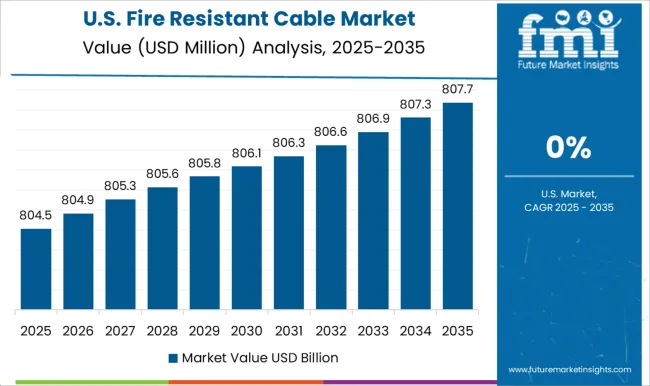
The fire-resistant cable market in the United States is expected to grow at a CAGR of 3.9%. The USA market remains steady, driven by the rising demand for fire-resistant solutions in the construction, automotive, and energy sectors. Stringent regulations on building safety, fire prevention, and electrical system standards continue to drive the adoption of fire-resistant cables in residential, commercial, and industrial applications. The growing push for smart building technologies, energy efficiency, and sustainability further accelerates the market demand for fire-resistant cables. Additionally, the increasing use of renewable energy systems and smart grid technologies in the USA supports the demand for fire-resistant cables in energy infrastructure.
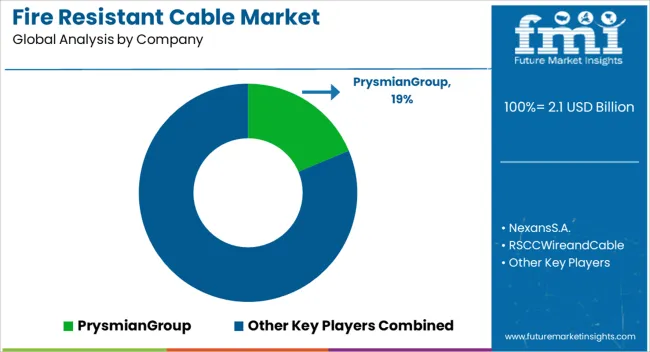
The fire-resistant cable market is dominated by Prysmian Group, which leads with its high-quality fire-resistant cables used in various industries, including construction, energy, and transportation. Prysmian’s dominance is supported by its extensive product range, global manufacturing capabilities, and a commitment to providing durable and reliable cable solutions that enhance safety and prevent fire hazards in electrical systems. Key players such as Nexans S.A., RSCC Wire and Cable, and Leoni AG maintain significant market shares by offering fire-resistant cables that comply with stringent safety standards and provide reliable performance under extreme conditions. These companies focus on improving the performance, flexibility, and fire resistance of their cables while expanding their product offerings for various industrial applications. Emerging players like TPC Wire & Cable Corp., KEI Industries Ltd., and RR Kabel are expanding their market presence by offering specialized fire-resistant cables tailored for niche applications such as high-temperature environments, oil and gas industries, and underground infrastructure projects.
Their strategies include focusing on material innovation, enhancing fire resistance capabilities, and offering cost-effective, durable solutions for safety-critical environments. Market growth is driven by the increasing need for safety in industrial and residential electrical systems, rising demand for reliable power transmission, and regulatory requirements for fire safety in buildings and transportation networks. Innovations in cable materials, advanced insulation technologies, and fire-resistant coatings are expected to continue shaping competitive dynamics and drive further growth in the global fire-resistant cable market.
| Item | Value |
|---|---|
| Quantitative Units | USD 2.1 Billion |
| Insulation Material | Low Smoke Zero Halogen (LSZH), Polyvinyl Chloride (PVC), Ethylene Propylene Rubber-Insulated (EPR), Cross Linked Poly Ethylene (XLPE), and Others |
| Regions Covered | North America, Europe, Asia-Pacific, Latin America, Middle East & Africa |
| Country Covered | United States, Canada, Germany, France, United Kingdom, China, Japan, India, Brazil, South Africa |
| Key Companies Profiled | PrysmianGroup, NexansS.A., RSCCWireandCable, TPCWire&CableCorp., ElsewedyElectric, KEIIndustriesLtd., LeoniAG, and RRKabel |
| Additional Attributes | Dollar sales by insulation material and application, demand dynamics across building & construction, energy, and transportation sectors, regional trends in fire-resistant cable adoption, innovation in halogen-free and low-smoke formulations, impact of regulatory standards on safety and environmental compliance, and emerging use cases in smart infrastructure and renewable energy systems. |
The global fire resistant cable market is estimated to be valued at USD 2.1 billion in 2025.
The market size for the fire resistant cable market is projected to reach USD 3.3 billion by 2035.
The fire resistant cable market is expected to grow at a 4.6% CAGR between 2025 and 2035.
The key product types in fire resistant cable market are low smoke zero halogen (LSZH), polyvinyl chloride (PVC), ethylene propylene rubber-insulated (EPR), cross linked poly ethylene (XLPE) and others.






Our Research Products

The "Full Research Suite" delivers actionable market intel, deep dives on markets or technologies, so clients act faster, cut risk, and unlock growth.

The Leaderboard benchmarks and ranks top vendors, classifying them as Established Leaders, Leading Challengers, or Disruptors & Challengers.

Locates where complements amplify value and substitutes erode it, forecasting net impact by horizon

We deliver granular, decision-grade intel: market sizing, 5-year forecasts, pricing, adoption, usage, revenue, and operational KPIs—plus competitor tracking, regulation, and value chains—across 60 countries broadly.

Spot the shifts before they hit your P&L. We track inflection points, adoption curves, pricing moves, and ecosystem plays to show where demand is heading, why it is changing, and what to do next across high-growth markets and disruptive tech

Real-time reads of user behavior. We track shifting priorities, perceptions of today’s and next-gen services, and provider experience, then pace how fast tech moves from trial to adoption, blending buyer, consumer, and channel inputs with social signals (#WhySwitch, #UX).

Partner with our analyst team to build a custom report designed around your business priorities. From analysing market trends to assessing competitors or crafting bespoke datasets, we tailor insights to your needs.
Supplier Intelligence
Discovery & Profiling
Capacity & Footprint
Performance & Risk
Compliance & Governance
Commercial Readiness
Who Supplies Whom
Scorecards & Shortlists
Playbooks & Docs
Category Intelligence
Definition & Scope
Demand & Use Cases
Cost Drivers
Market Structure
Supply Chain Map
Trade & Policy
Operating Norms
Deliverables
Buyer Intelligence
Account Basics
Spend & Scope
Procurement Model
Vendor Requirements
Terms & Policies
Entry Strategy
Pain Points & Triggers
Outputs
Pricing Analysis
Benchmarks
Trends
Should-Cost
Indexation
Landed Cost
Commercial Terms
Deliverables
Brand Analysis
Positioning & Value Prop
Share & Presence
Customer Evidence
Go-to-Market
Digital & Reputation
Compliance & Trust
KPIs & Gaps
Outputs
Full Research Suite comprises of:
Market outlook & trends analysis
Interviews & case studies
Strategic recommendations
Vendor profiles & capabilities analysis
5-year forecasts
8 regions and 60+ country-level data splits
Market segment data splits
12 months of continuous data updates
DELIVERED AS:
PDF EXCEL ONLINE
Firefighter Tapes Market Size and Share Forecast Outlook 2025 to 2035
Fire Pump Test Meter Market Size and Share Forecast Outlook 2025 to 2035
Fire Sprinkler System Market Size and Share Forecast Outlook 2025 to 2035
Fire Protection Materials Market Size and Share Forecast Outlook 2025 to 2035
Fire Extinguisher Market Size and Share Forecast Outlook 2025 to 2035
Fire Stopping Material Market Size and Share Forecast Outlook 2025 to 2035
Fireproof Insulation Market Size and Share Forecast Outlook 2025 to 2035
Fire Tube Chemical Boiler Market Size and Share Forecast Outlook 2025 to 2035
Firefighting Foam Market Size and Share Forecast Outlook 2025 to 2035
Fire Suppression System Market Size and Share Forecast Outlook 2025 to 2035
Fire Protection System Pipes Market Size and Share Forecast Outlook 2025 to 2035
Fire Stopping Materials Market Size and Share Forecast Outlook 2025 to 2035
Firefighting Drone Market Size and Share Forecast Outlook 2025 to 2035
Fire Door Market Size and Share Forecast Outlook 2025 to 2035
Fireclay Tiles Market Size and Share Forecast Outlook 2025 to 2035
Firearms Market Size and Share Forecast Outlook 2025 to 2035
Fire Collar Market Size and Share Forecast Outlook 2025 to 2035
Fire Protective Materials Market Size and Share Forecast Outlook 2025 to 2035
Fire And Explosion Proof Lights Market Size and Share Forecast Outlook 2025 to 2035
Fire Retardant Coatings Market Size and Share Forecast Outlook 2025 to 2035

Thank you!
You will receive an email from our Business Development Manager. Please be sure to check your SPAM/JUNK folder too.
Chat With
MaRIA